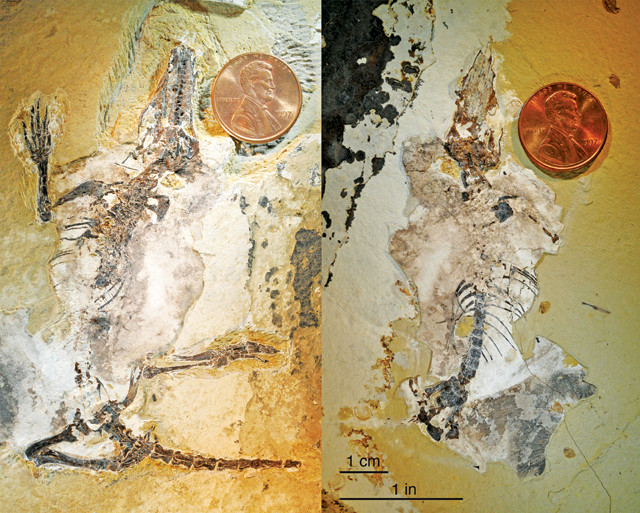
by Mary Caperton Morton Monday, June 1, 2015

These 160-million-year-old fossils of Docofossor (left) and Agilodocodon (right) represent the oldest burrowing and tree-climbing mammals, respectively. Credit: Zhe-Xi Luo, University of Chicago.
During the Mesozoic, mammals were small and inconspicuous, remaining hidden in the shadows of their larger reptilian neighbors and only diversifying into the many ecological niches they now occupy after the dinosaurs went extinct. Or so scientists thought. Now, two new shrew-sized fossils, each dating to about 160 million years ago, lend support to the alternative idea that mammals were ecologically diverse long before the dinosaurs left the scene.
With claws adapted for climbing and teeth for gnawing into trees to get at sap, Agilodocodon scansorius is the earliest-known tree-dwelling mammal. Meanwhile, Docofossor brachydactylus is the earliest-known subterranean mammal, possessing multiple adaptations for digging, such as shovel-like paws similar to those of African golden moles.
“We consistently find with every new fossil that the earliest mammals were just as diverse in both feeding and locomotor adaptations as modern mammals,” said Zhe-Xi Luo, an evolutionary biologist at the University of Chicago and a co-author of two new studies in Science, in a statement. “The groundwork for mammalian success today appears to have been laid long ago,” Luo said. “It appears dinosaurs did not dominate the Mesozoic landscape as much as previously thought.”
© 2008-2021. All rights reserved. Any copying, redistribution or retransmission of any of the contents of this service without the expressed written permission of the American Geosciences Institute is expressly prohibited. Click here for all copyright requests.